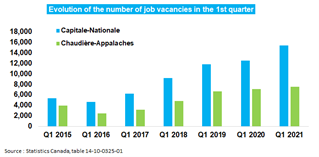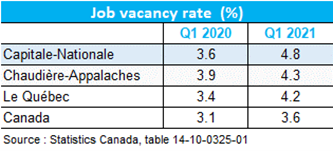Highlights
- According to Statistics Canada’s estimates, the number of vacant positions in the first quarter of 2021 was 15,350 in the Capitale-Nationale administrative region and 7,560 in Chaudière-Appalaches.
- Compared to the first quarter of 2020, this is an increase of 22.4% in the number of vacancies in the Capitale-Nationale and 6.6% in Chaudière-Appalaches.
- The proportion of vacancies in the employment market remained stable despite the pandemic, and the job vacancy rate increased to 4.8% in the Capitale-Nationale and 4.3% in the Chaudière-Appalaches in the first quarter of 2021.
- Workers in the occupational categories “sales and service”, “health” and “trades, transport and equipment operators” remained among the most in-demand.
- The average hourly wage offered for vacant positions increased, reaching $21.60 (+5.9%) in the Capitale-Nationale region and $20.60 (+9.6%) in Chaudière-Appalaches. The wages offered in the province of Quebec and Canada were $22.20 (+4.2%) and $23.60 (+4.4$), respectively.
Charts


Commentary
Statistics Canada’s Job Vacancy and Wage Survey (JVWS) estimations for the first quarter of 2021 reflect the labour market situation after one year of the pandemic. Note that during the first three months of 2021, major sanitary restrictions were in place in both the Capitale-Nationale and Chaudière-Appalaches regions. Public health measures varied throughout the territory during that period. In contrast, first-quarter data for the year 2020 reflect the situation before the pandemic.
The number of vacancies in the Capitale-Nationale and Chaudière-Appalaches regions reached 15,350 and 7,560 in the fourth quarter of 2021, a record high in both regions for that period of the year. Compared to the same period last year, this is an increase of 22.4% in the Capitale-Nationale and 6.6% in Chaudière-Appalaches.
The job vacancy rates reached 4.8% in the Capitale-Nationale region and 4.3% in Chaudière-Appalaches in the first quarter of 2021. These rates, which reflect the number of job vacancies expressed as a percentage of the total labour demand, reached a record high for that period of the year in both regions. The job vacancy rates in the Capitale-Nationale and Chaudière-Appalaches administrative regions were higher than those observed in the province of Quebec (4.2%) and Canada (3.6%). Compared to the first quarter of 2020, the weight of the job vacancies on the total labour demand grew in both administrative regions. In other words, the number of job vacancies increased in both absolute numbers and proportion.
On average, the hourly wage offered for vacant positions was $21.60 in the Capitale-Nationale and $20.60 in Chaudière-Appalaches in the first quarter this year. Compared to the same period in 2020, these wages grew by 5.9% and 9.6%, respectively. This increase was higher than in the province of Quebec (+4.2%) and Canada (+4.4%), with hourly wages established at $22.20 and $23.60.
Workers in the occupational categories “sales and service”, “health” and “trades, transport and equipment operators” remained among the most in-demand.
Capitale-Nationale (15,350 positions)
- Assisting occupations in support of health services (1,150)
- Computer and information systems professionals (1,110)
- Food counter attendants and kitchen helpers (1,050)
- Professional occupations in nursing (920)
Chaudière-Appalaches (7,560 positions)
- Labourers in processing, manufacturing, etc. (660)
- Retail salespersons (370)
- Food counter attendants and kitchen helpers (330)
- Other assembly and related occupations (300)
The year 2020 was marked by the pandemic and the exceptional variations that affected the labour market. Despite this unprecedented situation, JVWS data shows that labour recruitment difficulties remain a current concern, and the full reopening of the economy is likely to increase the labour market tightness.
Émile Émond
Economist
Québec International
Note to readers
- The job vacancy rate is the number of job vacancies expressed as a percentage of labour demand, i.e. all occupied and vacant jobs.
- JVWS data is not seasonally adjusted. Some caution is advised in interpreting the comparisons from one quarter to another, as these may take into account seasonal changes.
- Total labour demand is the sum of employed individuals (met labour demand) and the number of job vacancies (unmet labour demand).
- Each quarterly sample is divided into three distinct monthly groups, each using the first day of the month as the reference date. Respondents must provide the information based on the situation in their location on the first day of the month (the reference date).
- The survey’s target population includes all commercial locations in Canada, except those whose primary activity concerns the sectors of religious organizations and private households. Federal, provincial and territorial administrations are also excluded from the survey.
- Data by trade is provided for information purposes only and must be considered with caution due to the sample size. To learn more about the National Occupational Classification [NOC] minor groups presented above, please visit the Government of Canada’s website.




